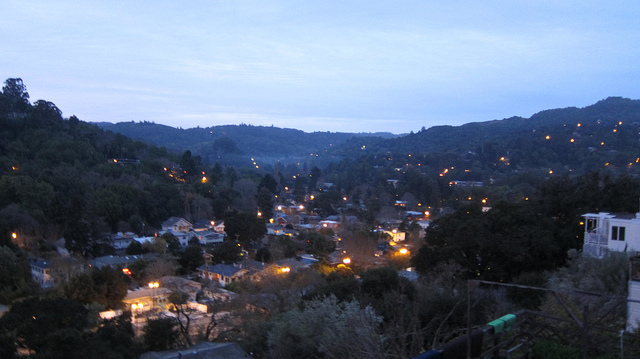 The Larkspur Landing Station Area Plan (SAP) is all the rage nowadays, and for good reason. People apparently don’t want to see any development or any changes to their community, and it looks like the development aspects of the plan are heading to the dustbin.
The Larkspur Landing Station Area Plan (SAP) is all the rage nowadays, and for good reason. People apparently don’t want to see any development or any changes to their community, and it looks like the development aspects of the plan are heading to the dustbin.
But there’s a myth Richard Hall, a leader in anti-development circles and writer of Planning for Reality, told me about yesterday on the IJ. He said the Larkspur SAP was necessary so SMART would get funding. Let’s fact-check this gem.
The claim
Under the Metroplitan Planning Commision’s (MTC) Resolution 3434, a commuter rail line like SMART can only get regional funding if it has an average of 2,200 housing units with a half-mile radius of its stations. MTC is in charge of dispersing regional funding from a variety of sources, and it’s entirely in its prerogative to disperse funds how it sees fit. Resolution 3434 is intended to promote transit-oriented development around train stations to limit sprawl out into the East Bay hills, farms, or elsewhere far from anything.
SMART, Hall claims, does not meet this requirement and needed to add 920 housing units around Larkspur Landing to qualify for MTC funding. Somehow Larkspur got involved, developed the plan, and now we’re headed for a train wreck of a plan.
The reality
There are a number of problems with this claim, highest on the list being that SMART has already qualified for regional funding under Resolution 3434. In fact, it was determined 4 years ago, in December, 2010, that SMART qualified for regional funding. SMART has since received funding and is using it to fund construction.
The finding was that SMART, excluding Corona Road and Novato North stations, had 15,251 housing units built or planned within a half-mile radius of its 7 planned stations. This is 99 percent of the required 15,400 units, and it was deemed sufficient.
Including Corona Road and Guernville Road, which was not the chosen plan MTC approved, there were 17,295 housing units out of 17,600 needed. It’s close, but not quite there.
Let’s say nothing happens in Larkspur except for a new station is built there. Let’s also say the planned Sonoma County Airport station is built and that SMART decides to open Corona Road. This means SMART will have 12 stations on tap, which means it needs at least 26,400 housing units within a half mile of its collection of stations.
Since I can’t find data on housing around either Novato North or the Sonoma County Airport, I’m going to say those have 0 units, just for the sake of argument. Adding up all the rest of the existing housing units gets us 19,796 housing units, well short of our needed 26,400.
However, San Rafael, Santa Rosa, and Petaluma have all completed station area plans. San Rafael plans for 272 more units downtown. Petaluma plans for 1,716 more units downtown and 523 more around its northern station. Santa Rosa plans for another 3,409 units around its downtown station and 2,680 around its northern station. This gets us to 28,396 total units, or 107 percent the needed amount.
A Rohnert Park SAP is also in the works, but it hasn’t been completed yet.
If there is a conspiracy afoot to get SMART to qualify for more regional funding through a Larkspur SAP, the conspirators are really bad at math. But if the author of Planning for Reality, a computer programmer, is similarly bad at math, perhaps we shouldn’t be so hard on them.
In sum: Hall’s claim is false.
What if there were no SAPs at all?
It’s important to note here that, when presented with this information, Hall shifted his tune both in email and online, choosing to criticize Sonoma for implementing SAPs and saying it was part of a bigger conspiracy for regional funding for construction. He also asked whether Larkspur Landing could have been included if no SAPs had been passed.
This question poses a highly improbable set of circumstances. First, Sonoma cities actually want to change, Rohnert Park especially. They believe their future lies in their downtowns, in the kind of places that Marin takes for granted. It is extremely likely they would have planned around their stations even if there were no MTC grant money, and likely would have planned even if SMART never existed.
Second, it was Larkspur, not SMART, that applied for SAP grant money. Anti-development activists believe MTC and SMART colluded to pressure Larkspur into taking that money against their will years before the Larkspur Landing station seemed possible. This was, they claim, to allow SMART to qualify for regional funding, even though it had already qualified for said funding.
But let's indulge them. Adding Larkspur Landing would have dropped the number of housing units from 99 percent of qualifying to 94 percent. However, as link of regional significance, it would be extremely unlikely that MTC would have allowed this to disqualify SMART. It was still largely in line with Resolution 3434, and there would have been strong pressure to keep the funding.
But there were SAPs passed, and SMART is going to open with 10 stations, not 7. It can easily add Corona Road for 11, and it looks like Larkspur Landing will open in 2017 for 12 stations. But perhaps we should forgive SMART for building itself. After all, it was voters - a more insidious force than any regional body - who put them up to it.












